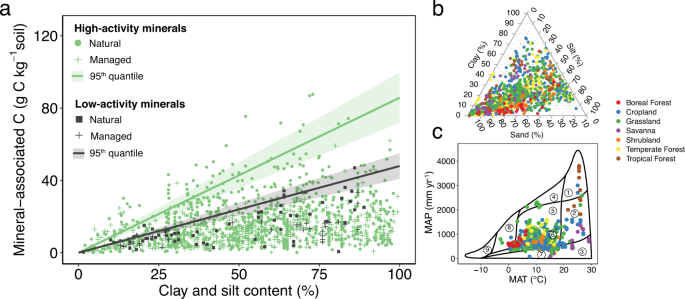2022-07-27 アメリカ・ローレンスリバモア国立研究所(LLNL)
ローレンス・リバモア国立研究所(LLNL)と国際共同研究チームは、このギャップを埋めるため、土壌鉱物に含まれる炭素と炭素貯蔵能力を空間的に分解して世界で初めて推定することに成功した。
この研究は、全世界に分布する1,144の土壌プロファイルから測定を行い、現在の鉱物性炭素蓄積と土壌の鉱物的容量からの逸脱に対する気候および管理の役割をより深く理解することを目的としています。
この研究では、農業管理下にある地域と土壌深層部では、鉱物性炭素の飽和度が最も低くなっていることがわかりました。
研究チームは、世界各地で行われた103の炭素蓄積量の測定結果から、土壌の鉱物学的容量から最も離れたところにある土壌が、より効果的に炭素を蓄積していることを明らかにした。炭素蓄積量の10分の1の土壌では、蓄積量の2分の1の土壌に比べ、平均3倍もの炭素蓄積量があることがわかった。
<関連情報>
- https://www.llnl.gov/news/research-reveals-where-carbon-storage-soils-has-most-potential
- https://www.nature.com/articles/s41467-022-31540-9
鉱物性土壌有機炭素のグローバルな蓄積量と容量 Global stocks and capacity of mineral-associated soil organic carbon
Katerina Georgiou,Robert B. Jackson,Olga Vindušková,Rose Z. Abramoff,Anders Ahlström,Wenting Feng,Jennifer W. Harden,Adam F. A. Pellegrini,H. Wayne Polley,Jennifer L. Soong,William J. Riley & Margaret S. Torn
Nature Communications Published:01 July 2022
DOI:https://doi.org/10.1038/s41467-022-31540-9

Abstract
Soil is the largest terrestrial reservoir of organic carbon and is central for climate change mitigation and carbon-climate feedbacks. Chemical and physical associations of soil carbon with minerals play a critical role in carbon storage, but the amount and global capacity for storage in this form remain unquantified. Here, we produce spatially-resolved global estimates of mineral-associated organic carbon stocks and carbon-storage capacity by analyzing 1144 globally-distributed soil profiles. We show that current stocks total 899 Pg C to a depth of 1 m in non-permafrost mineral soils. Although this constitutes 66% and 70% of soil carbon in surface and deeper layers, respectively, it is only 42% and 21% of the mineralogical capacity. Regions under agricultural management and deeper soil layers show the largest undersaturation of mineral-associated carbon. Critically, the degree of undersaturation indicates sequestration efficiency over years to decades. We show that, across 103 carbon-accrual measurements spanning management interventions globally, soils furthest from their mineralogical capacity are more effective at accruing carbon; sequestration rates average 3-times higher in soils at one tenth of their capacity compared to soils at one half of their capacity. Our findings provide insights into the world’s soils, their capacity to store carbon, and priority regions and actions for soil carbon management.


